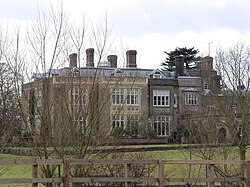

Viscount Knutsford, of Knutsford in the County Palatine of Chester, is a title in the Peerage of the United Kingdom.


Viscount Knutsford, of Knutsford in the County Palatine of Chester, is a title in the Peerage of the United Kingdom.
| Viscount Knutsford | |
|---|---|
  | |
| Crest | Out of a crown vallary Or a demi-lion guardant per bend Argent and Azure charged with a bendlet engrailed counterchanged holding in the dexter paw a fleur-de-lis Argent. |
| Supporters | On either side a lion guardant Argent gutté de larmes the body charged with two fleurs-de-lis in fess between two bars engrailed Azure. |
| Motto | Respice Aspice Prospice [1] |
It was created in 1895 for the lawyer, Conservative politician and former Secretary of State for the Colonies, Henry Holland, 1st Baron Knutsford. He had already been created Baron Knutsford, of Knutsford in the County Palatine of Chester, in 1888, also in the Peerage of the United Kingdom. His younger twin son, the third Viscount, assumed in 1876 by Royal licence the additional surname and arms of Hibbert. As of 2025 [update] the titles are held by the latter's great-grandson, the seventh Viscount, who succeeded his father in that year.
The Baronetcy, of Sandlebridge in the County Palatine of Chester, was created in the Baronetage of the United Kingdom on 10 May 1853 for the first Viscount's father, the prominent physician and travel writer Henry Holland.
The family seat is Munden House, near Watford, Hertfordshire.
The heir apparent is the present holder's son the Hon. Thomas Arthur Holland-Hibbert (born 1992)
{{cite book}}: CS1 maint: location (link)